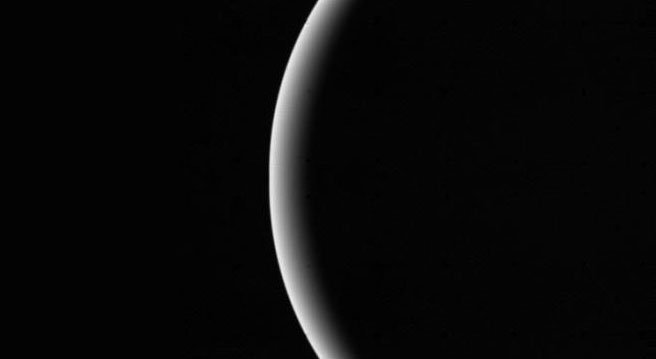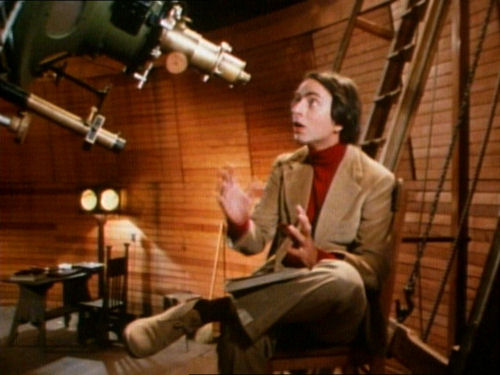
The crescent of Uranus, taken by Voyager 1 | NASA
Take time this month to give thanks, eat well, spend time with those you love, and of course, appreciate the beauty of the cosmos! This November will bring two meteor showers, a partial lunar eclipse (which we’ll be streaming live from our YouTube channel), and much more, plus some truly stellar moments in astronomy history. Read on to learn more about what’s up in the world of astronomy this month, and be sure to tune into the latest installment of our YouTube series, Mars Hill Almanac.
Night Sky Viewing
November 4 – New Moon
The Moon will located on the same side of the Earth as the Sun and will not be visible in the night sky. This phase occurs at 21:15 UTC. This is the best time of the month to observe faint objects such as galaxies and star clusters because there is no moonlight to interfere.
November 4, 5 – Taurids Meteor Shower
The Taurids is a minor meteor shower, producing only about 5-10 meteors per hour. The shower runs annually from September 7 to December 10, peaking this year on the the night of November 4. The New Moon will leave the skies dark for what should be a particularly spectacular show! The best viewing conditions will occur just after midnight. Meteors will appear to originate from the constellation Taurus, the bull, but can appear anywhere in the sky.
November 5 – Uranus at Opposition
Uranus will be at its closest approach to Earth and its surface will be fully illuminated by the Sun, making it appear brighter than it does during any other time of the year. It will also be visible all night long! Due to its distance, it will appear as a tiny blue-green dot in all but the most powerful telescopes.
November 17, 18 – Leonids Meteor Shower
At its peak, the Leonids produces up to 15 meteors per hour. The shower runs annually from November 6-30. This year, it peaks on the night of the 17th and into the morning of the 18th. The nearly full moon will dominate the sky during this time, blocking all but the brightest meteors. Best viewing will be from a dark location after midnight. Meteors will radiate from the constellation Leo, the lion, but can appear anywhere in the sky.
November 19 – Full Moon
The Moon will be located on the opposite side of the Earth from the Sun on the night of the 19th, meaning that its face will be will be fully illuminated. November’s full Moon is referred to as the Beaver Moon because this is the time of year that early Native Americans would set beaver traps before the swamps and rivers froze over.
November 19 – Partial Lunar Eclipse
During a partial lunar eclipse, a portion of the Moon moves into the darkest part of the Earth’s shadow, or umbra. As it does, you will be able to see part of the Moon’s surface darken into a deep reddish hue. The eclipse will be visible throughout most of eastern Russia, Japan, the Pacific Ocean, North America, Mexico, Central America, and parts of western South America. You can watch the eclipse live on our YouTube channel, starting at 12:15am MST on the 19th!
This Month in Astronomy History
November 1, 1977: Chiron is discovered
Chiron is a small, icy celestial body orbiting the Sun in the outer solar system among the giant planets. When it was first discovered by American astronomer Charles Kowal in 1977, it was classified as an asteroid and thought to be the most distant one to be discovered. Now, astronomers believe that it may have the composition of a comet nucleus (water ice, frozen gases, organic material, and dust) and travel in an unstable, eccentric orbit that enters those of Saturn and Uranus and takes roughly 50 Earth years to complete. Chiron’s unusual characteristics lead to the creation of a new object classification: Centaurs; icy, asteroid-sized objects with orbits that cross into those of the outer planets.
November 2, 1917: Hooker Telescope sees first light
The Hooker Telescope held the title of world’s largest telescope for over 40 years. However, it still holds an impressive title: at 101 inches across, 12 inches thick, and weighing in at almost 9,000 lbs, the telescope’s mirror remains the largest solid glass mirror ever made. It saw first light on the evening of November 2, 1917.
November 9, 1924: Carl Sagan is born
American astronomer, planetary scientist, cosmologist, astrophysicist, astrobiologist, and writer Carl Sagan is best known for his efforts toward the ongoing search for life on other planets. He assembled the very first messages sent into space, including the Pioneer Plaque and the Voyager Golden Record. This still image from Sagan’s television series ‘Cosmos: A Personal Journey’ shows him sitting inside our very own Clark Telescope, which was featured on an episode entitled “Blues for a Red Planet”.

November 11, 1916: Percival Lowell dies
American businessman, author, mathematician, astronomer, and observatory founder Percival Lowell passed away on November 12, 1916, just 14 years before the fabled ‘Planet X’ he spent a portion of his life searching for would be discovered. His final resting place, a mausoleum, sits just a stone’s throw from the dome of the historic 24″ Clark Refractor that he used to scour the surface of Mars for signs of intelligent life. During a time in which true enjoyment of the sciences was a luxury often reserved for the academic elite, Percival sought to popularize astronomy and share the wonders of the cosmos with the world at large.
November 12, 1980: Voyager 1 flies past Saturn
Voyager 1 was the second spacecraft to complete a flyby of Saturn. During its mission, the craft conducted studies of Jupiter, Saturn, Saturn’s rings, and the larger moons of both planets. It was launched from Cape Canaveral on September 5, 1977, and began photographing Jupiter in January of 1979. It approached Saturn 3 years later in November of 1980, making its closest approach on the 12th. Voyager 1 found that about seven percent of the volume of Saturn’s upper atmosphere is helium, while almost all the rest is hydrogen.
November 13, 1971: Mariner 9 orbits Mars
Mariner 9 became the first spacecraft to orbit Mars in November of 1971. The craft was designed and developed by NASA’s Jet Propulsion Lab (JPL) with the purpose of exploring our nearest planetary neighbors: Venus, Mercury, and Mars. There were 10 Mariner missions in all, which launched between 1962 and 1973 and revisited Venus and Mars to make additional observations.
November 19, 1969: Apollo 12 lands on the Moon
Apollo 12 was the second manned mission to land on the surface of the Moon. Its primary objectives included performing inspection, survey and sampling in lunar mare area, deploying an Apollo Lunar Surface Experiment Package (ALSEP), developing techniques for a point landing capability and capability to work in the lunar environment, and obtaining photographs of candidate exploration sites.
November 20, 1889: Edwin Hubble is born
American astronomer Edwin Hubble was born in Marshfield, Missouri on November 20, 1889. He is best known for his vital role in establishing the fields of extragalactic astronomy and observational cosmology. He is generally regarded as the most influential observational cosmologist of the 20th century.
November 22, 1682: Edmond Halley sees the comet that will later bear his name
Halley’s Comet is a short-period comet that is visible from Earth every 75 to 76 years. It is the only comet that can be seen with the unaided eye and can appear twice in a human lifetime. It was officially discovered by English astronomer Edmond Halley on November 22, 1682, though evidence of it being seen from Earth may have been recorded as early as 467 BC.
November 28, 1967: Jocelyn Bell discovers first pulsar
Irish astrophysicist Jocelyn Bell discovered the first radio pulsars as a postgraduate student at the University of Cambridge in 1967. This discovery eventually earned the Nobel Peace Prize in Physics in 1974, but Bell herself was not awarded the prize. This omission was the subject of controversy, but Bell herself commented, “I believe it would demean Nobel Prizes if they were awarded to research students, except in very exceptional cases, and I do not believe this is one of them.” In 2018, she was awarded the Special Breakthrough Prize in Fundamental Physics. Following the announcement of the award, she decided to give the whole of the £2.3 million prize money to help female, minority, and refugee students seeking to become physics researchers, the funds to be administered by the Institute of Physics.